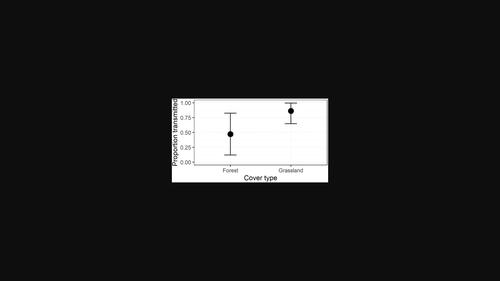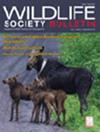评估细胞传输技术在野生动物研究相机诱捕中的效果
IF 1.5
4区 环境科学与生态学
Q3 Environmental Science
引用次数: 0
摘要
摄像机陷阱是一种重要的非侵入性工具,被科学家用来高效、低成本地监测野生动物。新的相机陷阱功能提高了性能,并鼓励更多的研究人员和公众使用。图像数据的蜂窝传输为用户提供了数字接收图像的能力,而不是在现场检索或下载图像,这是一个有用的新功能。蜂窝数据传输对野生动物研究有两个关键的好处,一是它减少了下载图像数据所需的时间,减少了SD卡存储容量和电池寿命的不确定性,二是蜂窝传输允许对图像进行近实时分析,这可以重新分配通常用于处理大型数据集的时间,当存储卡被检索时。尽管有潜在的好处,但相机陷阱中的蜂窝传输技术仍然是新的,其可靠性仍然存在问题。我们的目标是通过设计一个相机陷阱研究来确定细胞传输技术在野生动物研究中的功效,作为高级课程的一部分(野生动物管理应用和规划;俄克拉荷马州立大学的NREM 4522)项目。从2021年9月5日至10月5日,我们使用ArcGIS生成陷阱位置的分层随机样本,在开放草原和封闭冠层森林地区部署了5个蜂窝传输相机陷阱。我们每天在线监测传输图像的数量,在检索相机陷阱后,我们将传输图像的数量与存储在存储卡上的图像进行比较,以确定传输效率。我们的数据表明,每天拍摄的大部分图像都被成功传输;然而,传输效率(即传输的数量除以摄像机捕获的总数)在森林地区(47%)往往低于开阔草地(86%)。尽管蜂窝传输技术显示出前景,但蜂窝信号、景观特征和传输数据质量的结合可能会限制蜂窝传输技术在近实时数据分析中的有效性。基于我们的研究结果,我们建议研究人员在设计研究时考虑蜂窝传输的优点和缺点,并注意到研究人员可能需要采用自适应方法或进行包括量化传输功能的试点测试。本文章由计算机程序翻译,如有差异,请以英文原文为准。

Assessing efficacy of cellular transmission technology in camera trapping for wildlife research
Abstract Camera traps are an important noninvasive tool used by scientists to monitor wildlife efficiently and at reduced costs. New camera trap features improve performance and encourage increased use by researchers and the public. Cellular transmission of image data, which provides users the ability to digitally receive images instead of retrieving or downloading images in the field is a useful new feature. Cellular data transmission has 2 key benefits for wildlife research in that it reduces travel time required for downloading image data and the uncertainty involving storage capacity of SD cards and battery life, and cellular transmission allows for near real‐time analysis of images, which could redistribute the time usually devoted to processing a large data set when the memory card is retrieved. Despite potential benefits, cellular transmission technology in camera traps is still new and questions remain about its reliability. Our objective was to determine the efficacy of cellular transmission technology in wildlife research by designing a camera trap study as part of a senior‐level class (Wildlife Management Applications and Planning; NREM 4522) project at Oklahoma State University. We used ArcGIS to generate a stratified random sample of trap locations, deploying five cellular transmission camera traps in open grassland and five in closed canopy forest areas from 5 September to 5 October 2021. We monitored the number of transmitted images each day online, and after camera trap retrieval, we compared the number of transmitted images to those stored on the memory card to determine transmission efficiency. Our data indicated the majority of the images taken each day were transmitted successfully; however, transmission efficiency (i.e., number transmitted divided by total number taken by the camera trap) tended to be lower in forested areas (47%) compared to open grassland (86%). Though cellular transmission technology shows promise, the combination of cellular signal, landscape features, and transmitted data quality may limit the effectiveness of cellular transmission technology for near real‐time data analysis. Based on our results, we recommend that researchers consider advantages and disadvantages of cellular transmission when designing studies and note that researchers may need to adopt an adaptive approach or conduct pilot testing that includes quantifying the transmission functionality.
求助全文
通过发布文献求助,成功后即可免费获取论文全文。
去求助
来源期刊

Wildlife Society Bulletin
BIODIVERSITY CONSERVATION-
CiteScore
2.10
自引率
13.30%
发文量
0
期刊介绍:
The Wildlife Society Bulletin is a journal for wildlife practitioners that effectively integrates cutting edge science with management and conservation, and also covers important policy issues, particularly those that focus on the integration of science and policy. Wildlife Society Bulletin includes articles on contemporary wildlife management and conservation, education, administration, law enforcement, and review articles on the philosophy and history of wildlife management and conservation. This includes:
Reports on practices designed to achieve wildlife management or conservation goals.
Presentation of new techniques or evaluation of techniques for studying or managing wildlife.
Retrospective analyses of wildlife management and conservation programs, including the reasons for success or failure.
Analyses or reports of wildlife policies, regulations, education, administration, law enforcement.
Review articles on the philosophy and history of wildlife management and conservation. as well as other pertinent topics that are deemed more appropriate for the Wildlife Society Bulletin than for The Journal of Wildlife Management.
Book reviews that focus on applied research, policy or wildlife management and conservation.
 求助内容:
求助内容: 应助结果提醒方式:
应助结果提醒方式:


